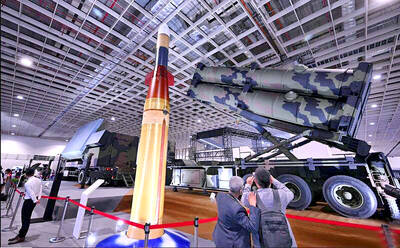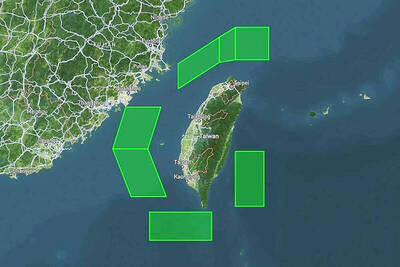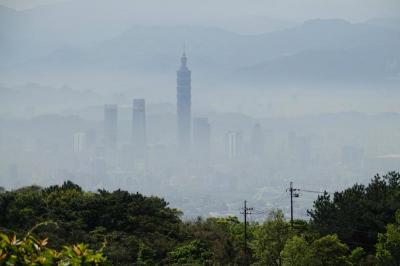Taiwan’s armed forces must learn to embrace innovation, accept risks and confront problems with honesty to get out of the doldrums of “preparing for yesterday’s war,” retired admiral Lee Hsi-ming (李喜明), former chief of the general staff, told a news conference at the Taipei School of Economics and Political Science Foundation on Friday.
The foundation held the event to release its 2022-2023 Republic of China National Defense Review.
National defense strategy, joint warfare, cyberoperations, strategic reserve forces and self-reliant national defense were the key aspects of defense underscored by the paper, which focussed on providing alternative policies for the government’s consideration, Lee said.

Photo: Liao Chen-huei, Taipei Times
Taiwan faces existential and coercive threats, with China’s utilization of “gray zone” conflict encapsulating the latter, he said, adding that gray zone conflict is characterized by using the threat of force to create fear and intimidation.
Taiwan lacks the sufficient military capability to address coercive threats, which highlights the urgent need for applying asymmetry to national defense in all domains, he said.
Instead of spending its limited resources on larger orders of fighter jets and warships, Taiwan should keep Beijing’s tactics in check by using crewed systems and remaining calm without losing perspective, Lee said.
Some analysts have called attention to the Chinese People’s Liberation Army (PLA) Navy’s construction of new aircraft carriers and argued that these surface combatants could be deployed in a hypothetical blockade of Taiwan, he said.
The analysts are mistaken because they do not grasp that the purpose of the carriers is to serve Beijing’s quest for global hegemony, not be deployed immediately in the Taiwan Strait, Lee’s said.
Chinese carriers are not likely to play a significant role in a war against Taiwan, as they are part of Beijing’s effort to build a first-rate military that can project power on a global scale by 2049, not to be immediately risked in the Taiwan Strait, he said.
Should the PLA launch an attack on Taiwan, its main goal would be to overcome the resistance of defending forces while preventing the US or other nations from interfering with its invasion, he said.
China’s advanced ballistic missiles, submarines and bombers are far more effective weapons in accomplishing these aims than deploying aircraft carriers in an anti-access, area-denial role, Lee said, adding that the US is clearly more troubled by these PLA capabilities.
Regarding cyberwarfare, Lee said that the military’s Information, Communications and Electronic Force Command appears to have neglected the Internet, which does not fall into the military definition of information, communications or electronic warfare.
Contesting the Internet space is a crucial mission that the armed forces of the US and Israel have integrated into their military intelligence services, he said, adding that intelligence is foundational to successful operations on the Internet.

Taiwan is to commence mass production of the Tien Kung (天弓, “Sky Bow”) III, IV and V missiles by the second quarter of this year if the legislature approves the government’s NT$1.25 trillion (US$39.78 billion) special defense budget, an official said yesterday. Commenting on condition of anonymity, a defense official with knowledge of the matter said that the advanced systems are expected to provide crucial capabilities against ballistic and cruise missiles for the proposed “T-Dome,” an advanced, multi-layered air defense network. The Tien Kung III is an air defense missile with a maximum interception altitude of 35km. The Tien Kung IV and V

The disruption of 941 flights in and out of Taiwan due to China’s large-scale military exercises was no accident, but rather the result of a “quasi-blockade” used to simulate creating the air and sea routes needed for an amphibious landing, a military expert said. The disruptions occurred on Tuesday and lasted about 10 hours as China conducted live-fire drills in the Taiwan Strait. The Civil Aviation Administration (CAA) said the exercises affected 857 international flights and 84 domestic flights, affecting more than 100,000 travelers. Su Tzu-yun (蘇紫雲), a research fellow at the government-sponsored Institute for National Defense and Security Research, said the air

A strong continental cold air mass is to bring pollutants to Taiwan from tomorrow, the Ministry of Environment said today, as it issued an “orange” air quality alert for most of the country. All of Taiwan except for Hualien and Taitung counties is to be under an “orange” air quality alert tomorrow, indicating air quality that is unhealthy for sensitive groups. In China, areas from Shandong to Shanghai have been enveloped in haze since Saturday, the ministry said in a news release. Yesterday, hourly concentrations of PM2.5 in these areas ranged from 65 to 160 micrograms per cubic meter (mg/m³), and pollutants were

Taiwan’s armed forces have established response protocols for a wide range of sudden contingencies, including the “Wan Chun Plan” to protect the head of state, the Ministry of Defense (MND) said today. After US President Donald Trump on Saturday launched a series of airstrikes in Venezuela and kidnapped Venezuelan President Nicolas Maduro, concerns have been raised as to whether China would launch a similar “decapitation strike” on Taiwan. The armed forces regularly coordinate with relevant agencies and practice drills to ensure preparedness for a wide range of scenarios, Vice Minister of National Defense Hsu Szu-chien (徐斯儉) told reporters before a